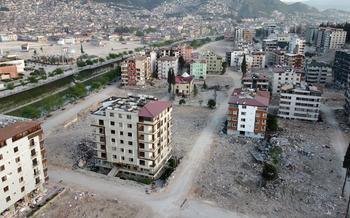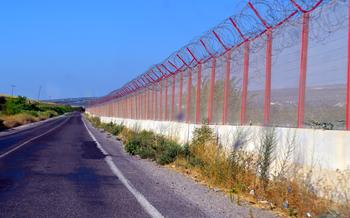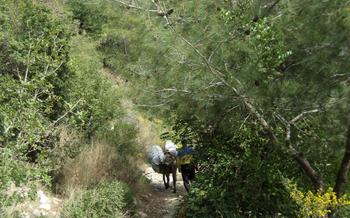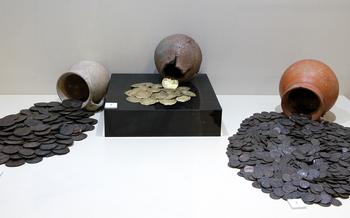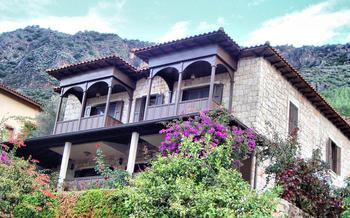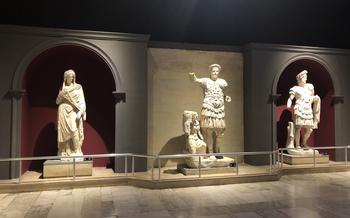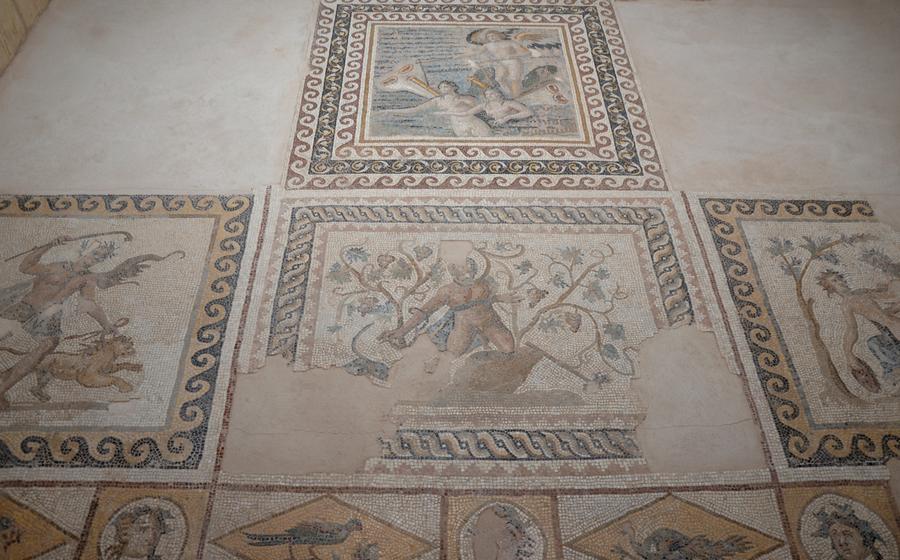
Hatay Archaeology Museum
- Historical Background
- Museum Overview
- Exhibits and Collections
- Interactive Displays
- Thematic Sections
- Temporary Exhibitions
- Guided Tours
- Museum Facilities
- Accessibility
- Educational Programs
- Research Center
- Conservation Laboratory
- Community Outreach
- Location and Transportation
- Insider Tip:
Historical Background
Hatay, a land steeped in history, has witnessed the rise and fall of numerous civilizations, leaving behind a rich tapestry of cultural heritage. Strategically positioned at the crossroads of ancient trade routes, Hatay served as a melting pot of diverse cultures, from the Hittites and Romans to the Byzantines and Ottomans. This unique location fostered a vibrant exchange of ideas, traditions, and artistic influences, shaping the region's distinct identity.
As a historical crossroads, Hatay played a pivotal role in connecting the East and the West. The region's fertile lands and access to the Mediterranean Sea attracted traders, travelers, and conquerors throughout history. The diverse cultural influences that converged in Hatay resulted in a rich and diverse heritage, evident in its architecture, cuisine, and traditions.
Exploring Hatay's history is a journey through time, revealing the layers of civilizations that have left their mark on this remarkable region. From ancient ruins to medieval castles and Ottoman mosques, Hatay offers a glimpse into the past, inviting visitors to unravel the stories of a land that has witnessed the passage of empires and the birth of new nations.
Museum Overview
The Hatay Archaeology Museum stands as a testament to the region's rich cultural heritage, a treasure trove of ancient artifacts that narrate the story of Hatay's past. Founded in 1934, the museum is renowned for its impressive collection of archaeological wonders, meticulously preserved and showcased for the world to admire. Its mission is to safeguard and present the region's cultural legacy, providing visitors with a glimpse into the civilizations that once flourished on this historic land.
The museum's collection spans various eras and civilizations, from the earliest settlements to the grandeur of the Roman Empire and beyond. Among its prized possessions are prehistoric tools, stunning sculptures, intricate mosaics, and exquisite jewelry, each piece a testament to the artistry and craftsmanship of ancient masters. These artifacts offer a tangible connection to the region's diverse cultural influences, inviting visitors on a journey through time to discover the stories they hold.
Exhibits and Collections
The Hatay Archaeology Museum boasts a diverse and impressive collection of artifacts that span various eras and civilizations. From prehistoric tools and weapons to ancient sculptures, mosaics, and jewelry, the museum offers a glimpse into the rich cultural heritage of the region.
Among the museum's most notable exhibits is the statue of the "Weeping Woman." This poignant sculpture, dating back to the Hellenistic period, is believed to represent the mourning of the city of Antioch after its destruction by an earthquake. The statue's expressive face and intricate details have captivated visitors for centuries.
Another highlight of the museum is the "Mosaic of the Muses." This stunning mosaic, discovered in the ancient city of Daphne, depicts the nine Muses, goddesses of the arts and sciences. The mosaic's vibrant colors, intricate patterns, and lifelike representations of the Muses have earned it recognition as one of the finest examples of Roman mosaic art.
These artifacts, along with numerous others, provide valuable insights into the lives, beliefs, and artistic expressions of the ancient inhabitants of Hatay. Through these exhibits, visitors can trace the region's cultural evolution and gain a deeper understanding of its historical significance.
Interactive Displays
The Hatay Archaeology Museum takes pride in its interactive displays and educational programs, designed to engage visitors of all ages and make learning about the region's history and culture a fun and memorable experience. Through the use of multimedia presentations, touchscreens, and 3D models, the museum brings history to life and allows visitors to explore the past in a truly immersive way.
Interactive displays are strategically placed throughout the museum, inviting visitors to engage with the exhibits and deepen their understanding of the artifacts and their significance. Multimedia presentations offer detailed information about specific periods and civilizations, while touchscreens provide interactive maps, timelines, and quizzes that test visitors' knowledge and keep them entertained.
One of the most popular interactive displays is the 3D model of the ancient city of Antioch, which allows visitors to virtually explore the city's streets, buildings, and landmarks. This immersive experience transports visitors back in time and gives them a glimpse into the bustling life of one of the most important cities of the ancient world.
The Hatay Archaeology Museum's interactive displays not only enhance the museum experience but also promote a deeper appreciation for the region's rich history and cultural heritage. By making learning interactive and enjoyable, the museum encourages visitors to explore, discover, and connect with the past in a meaningful way.
Thematic Sections
The Hatay Archaeology Museum is divided into several thematic sections, each dedicated to a specific civilization or period in the region's history. These sections provide a comprehensive overview of Hatay's rich cultural heritage and allow visitors to delve deeper into the unique contributions of each civilization.
One of the most notable sections is dedicated to the Hittites, an ancient Anatolian civilization that flourished in the Bronze Age. Here, visitors can admire impressive stone sculptures, including the famous "Sphinx of Alacahöyük," which dates back to the 14th century BC. The Hittite section also features cuneiform tablets, jewelry, and other artifacts that shed light on their advanced writing system, religious beliefs, and daily life.
Another significant section focuses on the Romans, who ruled Hatay for several centuries. This section showcases well-preserved mosaics, including the stunning "Mosaic of the Muses," which depicts the nine muses of Greek mythology. Visitors can also view Roman sculptures, coins, and pottery, gaining insights into the Roman Empire's administrative, economic, and cultural influence on the region.
The Byzantine section, representing the period of the Eastern Roman Empire, displays exquisite examples of Byzantine art and architecture. Visitors can admire intricate mosaics, frescoes, and stone carvings that adorned Byzantine churches and palaces. The section also features artifacts related to the region's Christian heritage, such as crosses, icons, and religious manuscripts.
These thematic sections, dedicated to specific civilizations and periods, offer a comprehensive journey through Hatay's rich history. By exploring each section, visitors can gain a deeper understanding of the diverse cultural influences that have shaped the region, making it a true melting pot of civilizations.
Temporary Exhibitions
The Hatay Archaeology Museum regularly organizes temporary exhibitions that showcase specific themes or collections, adding a dynamic and ever-changing element to the museum's offerings. These exhibitions often explore particular aspects of Hatay's history, culture, or archaeology, presenting unique artifacts and insights that complement the permanent collection.
Past temporary exhibitions have covered a wide range of topics, from the ancient trade routes of Hatay to the region's rich culinary heritage. One notable exhibition, titled "Treasures of the Hittites," showcased a collection of rare artifacts from the Hittite civilization, including gold jewelry, bronze sculptures, and cuneiform tablets. Another exhibition, "Mosaics of Antioch," presented a stunning array of mosaic artworks discovered in the ancient city of Antioch, offering a glimpse into the city's vibrant artistic traditions.
Temporary exhibitions at the Hatay Archaeology Museum are a great way to delve deeper into specific aspects of the region's history and culture. They provide visitors with an opportunity to see unique artifacts that may not be on permanent display and to learn about new research and discoveries. The museum's commitment to hosting these temporary exhibitions ensures that its content remains fresh and engaging, attracting visitors time and again.
Guided Tours
The Hatay Archaeology Museum offers guided tours in various languages, including English, Turkish, Arabic, and French. These tours are led by experienced and knowledgeable guides who provide in-depth insights into the museum's collection and the region's rich history. Visitors can choose from a variety of tour options, depending on their interests and time constraints.
A guided tour is an excellent way to make the most of your visit to the museum. The guides will take you through the different exhibits, explaining the significance of each artifact and its cultural context. They will also answer any questions you may have and provide additional information that is not available in the exhibits.
To book a guided tour, visitors can contact the museum in advance or inquire at the information desk upon arrival. Guided tours are available at specific times throughout the day, and reservations are recommended to ensure availability.
Museum Facilities
The Hatay Archaeology Museum offers a range of facilities to enhance visitors' experience and cater to their needs. Visitors can browse the museum's gift shop for souvenirs, books, and replicas of artifacts to take home as mementos of their visit. The museum also houses a specialized library that houses a collection of books, journals, and research materials related to archaeology, history, and culture of Hatay and the surrounding region. This resource-rich library is a valuable asset for researchers, students, and those seeking in-depth knowledge about the region's past.
Furthermore, visitors can relax and refuel at the museum's café, which offers a selection of refreshments, snacks, and light meals. The café provides a tranquil space where visitors can take a break from their exploration, reflect on what they have learned, and engage in discussions about the museum's exhibits. The combination of the gift shop, library, and café creates a well-rounded museum experience that caters to the diverse needs and interests of visitors, allowing them to delve deeper into the history and culture of Hatay.
Accessibility
The Hatay Archaeology Museum is committed to providing an inclusive and welcoming environment for all visitors, including those with disabilities. The museum features a range of accessibility features to ensure that everyone can enjoy the exhibits and learn about the region's rich history and culture.
Visitors with mobility impairments can easily navigate the museum's spacious galleries and exhibits using ramps and elevators. Accessible restrooms are also available throughout the museum. The museum staff is trained to assist visitors with disabilities and provide any necessary support.
In addition to physical accessibility features, the museum offers a range of materials and services to make exhibits accessible to visitors with sensory impairments or cognitive disabilities. Audio guides and descriptive panels are available for visitors who are blind or visually impaired. The museum also offers guided tours in sign language for visitors who are deaf or hard of hearing.
The Hatay Archaeology Museum's commitment to accessibility ensures that everyone can enjoy and benefit from the museum's collections and educational programs. Whether you are a visitor with a disability or simply someone who appreciates a well-designed and accessible museum, the Hatay Archaeology Museum is a great place to visit.
Educational Programs
The Hatay Archaeology Museum recognizes the importance of education and offers a range of educational programs and workshops designed to engage students, families, and community groups. These programs aim to promote cultural awareness, foster a love of history, and inspire the next generation of archaeologists and heritage enthusiasts.
The museum's educational programs are diverse and cater to different age groups and interests. Guided tours led by experienced educators provide an immersive experience, allowing visitors to explore the museum's exhibits and artifacts in-depth. Lectures and talks by renowned archaeologists and historians offer insights into the latest research and discoveries, shedding light on Hatay's rich past.
Interactive workshops and hands-on activities encourage active participation and make learning about history fun and engaging. Children can participate in art and craft workshops inspired by ancient civilizations, while families can engage in treasure hunts or interactive quizzes that test their knowledge of Hatay's history and culture.
The museum's educational programs are not limited to the classroom. The museum also organizes outreach programs, such as mobile exhibitions and educational events in schools and community centers, to reach a wider audience and promote cultural understanding. These programs play a vital role in fostering a sense of pride and connection to the region's rich heritage.
Research Center
Nestled within the Hatay Archaeology Museum is a treasure trove of knowledge and expertise: the Research Center. Dedicated to preserving and documenting Hatay's rich cultural heritage, this center is a hub of scholarly activity and archaeological research. Here, a team of dedicated researchers delves into the region's past, unearthing new insights and shedding light on the civilizations that once thrived in this fertile land.
The Research Center plays a pivotal role in advancing our understanding of Hatay's history. Through meticulous excavations, surveys, and studies, the researchers uncover artifacts, analyze ancient texts, and reconstruct the lives of past inhabitants. Their findings contribute to a deeper comprehension of the region's cultural evolution, shedding light on the interactions between different civilizations and the factors that shaped their unique identities.
The center's resources are extensive, encompassing a vast collection of archaeological data, maps, photographs, and publications. These resources are meticulously cataloged and made accessible to scholars, students, and the public, fostering a vibrant intellectual community dedicated to preserving Hatay's cultural legacy. The center also collaborates with universities, museums, and institutions worldwide, facilitating knowledge exchange and promoting international cooperation in the field of archaeology.
Conservation Laboratory
Nestled within the Hatay Archaeology Museum is a hidden gem—the conservation laboratory. Here, a team of skilled conservators works tirelessly behind the scenes to preserve and restore the museum's priceless artifacts. Using delicate techniques and specialized equipment, they breathe new life into ancient treasures, ensuring their preservation for future generations.
The conservation laboratory is a sanctuary of meticulous care, where each artifact is treated with the utmost respect. Conservators carefully examine each piece, identifying areas of damage or deterioration. They then employ a range of techniques, from gentle cleaning to complex restoration procedures, to bring the artifacts back to their former glory.
The work of the conservators is essential in preserving Hatay's rich cultural heritage. Through their dedication and expertise, they ensure that the museum's collection remains a vibrant testament to the region's storied past. Visitors may not always see the conservators at work, but their contributions are evident in every restored artifact on display.
Community Outreach
The Hatay Archaeology Museum recognizes the importance of engaging with the local community and promoting cultural understanding. It actively participates in various outreach programs to connect with people from all walks of life. These programs aim to foster a sense of ownership and appreciation for the region's rich heritage.
The museum organizes regular lectures, workshops, and exhibitions that are open to the public. These events provide opportunities for experts, scholars, and community members to share their knowledge, insights, and experiences related to Hatay's history and culture. The lectures cover diverse topics, ranging from archaeological discoveries to the region's unique traditions and folklore.
Moreover, the museum collaborates with local schools and educational institutions to develop educational programs and activities for students of all ages. These programs include guided tours, hands-on workshops, and interactive sessions that bring history to life for young learners. By engaging with students, the museum hopes to instill a sense of appreciation for their cultural heritage and inspire future generations of archaeologists and historians.
Community outreach initiatives also extend to local artisans, craftsmen, and cultural groups. The museum provides a platform for these individuals to showcase their talents and share their knowledge of traditional arts, crafts, and customs. Through these collaborations, the museum promotes the preservation and revitalization of Hatay's intangible cultural heritage.
By actively engaging with the community, the Hatay Archaeology Museum fosters a sense of pride and ownership among the local population. It creates a space for diálogo, learning, and cultural exchange, contributing to a vibrant and inclusive community that values its rich heritage.
Location and Transportation
The Hatay Archaeology Museum is conveniently located in the heart of Antakya, the capital city of Hatay province. Its exact address is Kurtulus Mahallesi, Saray Cad. No:14, 31000 Antakya/Hatay. To reach the museum, visitors can take advantage of the city's public transportation system. Several bus lines, including the 4, 7, and 11, stop within walking distance of the museum. Alternatively, visitors can opt for a taxi or ride-sharing service, which are readily available in Antakya. For those arriving by car, there is limited street parking available in the vicinity of the museum. A map or directions can be easily accessed online or obtained from the museum's website or local tourist information centers.
Insider Tip:
As an avid history buff, I highly recommend visiting the Hatay Archaeology Museum on a weekday morning to avoid the weekend crowds. This will give you ample time to explore the museum's vast collection and delve into the region's rich history without feeling rushed.
One exhibit that often goes unnoticed is the "Mosaic of the Muses," located in the Roman section of the museum. This stunning mosaic depicts the nine muses, each representing a different art or science. Take a moment to admire the intricate details and vibrant colors of this masterpiece, which offers a glimpse into the artistic achievements of the Roman era in Hatay.
Remember to bring a camera to capture the museum's many treasures, and don't forget to visit the gift shop for unique souvenirs and replicas of artifacts. Enjoy your journey through time at the Hatay Archaeology Museum!

